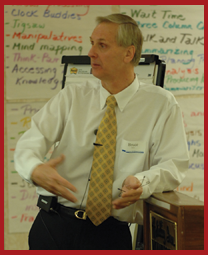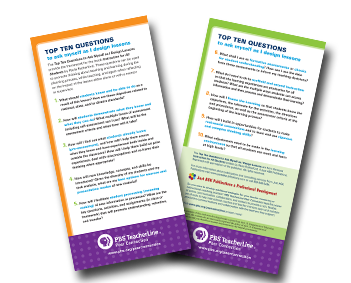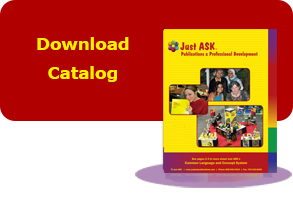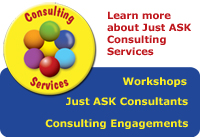
Volume IX Issue VI
Share this newsletter on
Fresh Perspectives

Bruce facilitating a Leading the Learning® workshop
As professionals, it is imperative that we keep our minds open to new ways of thinking or new findings in the field of education. Consider what an unexciting and troubled world we would live in if the medical profession did not carry out ongoing research to discover new treatments or potential cures for diseases; if scientists were not continually conducting experiments to learn about exciting innovations that have the potential to improve our daily lives; or if experts in the field of technology were satisfied with the status quo and did not continue to search for ways to better communicate on a worldwide scale and advance our ability to learn about and interact with one another. We must also be willing to search for, discuss, debate, and augment current educational approaches with fresh ideas. We must be willing to consider alternative points of view that may shed new light on the work we do.
Some colleges and universities are moving away from the lecture.
As Catholic University chemistry professor Diane Bunce has espoused, “Learning doesn’t happen in the physical space between the instructor and the student. Learning happens in the student’s mind.” There is increasing evidence that the education reform movement is having an impact, not simply in K-12 settings, but in college classes as well. Although the lecture is the predominant teaching method in many university settings, higher education leaders are finding that it is a “turn off” for students, especially in science, engineering, and mathematics classes. As a result, college level instructors are abandoning or retooling the lecture format as a style of teaching. As they reexamine the lecture approach, they are also reevaluating the practice in terms of its impact on real student learning.
According to a recent Washington Post article, “Since the 1990s, research on pedagogy has shifted from what instructors teach to what students learn. And studies have shown students in traditional lecture courses learn comparatively little.” www.washingtonpost.com/local/education/colleges-looking-beyond-the-lecture/2012/02/03/gIQA7iUaGR_print.html. With the Internet readily available to students, they can go online and view a lecture on a topic under study thus negating the importance of a duplicate lecture on the same topic in a class. For example, The Khan Academy, found at www.khanacademy.org, provides free materials and resources including over 3,000 videos for the use of all. As the website says, “It doesn’t matter if you are a student, teacher, home-schooler, principal, adult returning to the classroom after 20 years, or a friendly alien just trying to get a leg up in earthly biology.”
Harvard physics professor Eric Mazur is noted not only for his impressive work in the field of physics, but for his twenty year quest for teaching methods that promote real learning of physics concepts. Mazur has concluded that learning is a “social experience.” Thus, a student must view himself as “an active explainer rather than a passive sponge.” Students in Mazur’s classroom are engaged in interactive instruction, applying content to real work problems, and grappling with questions in small groups. Watch the YouTube clip: Confessions of a Converted Lecturer: Eric Mazur at www.youtube.com/watch?v=WwslBPj8GgI
The business community needs more than great test takers.
Test scores continue to play a prominent role in the lives of public school educators since a school’s success (or lack of success) is often narrowed down to annual achievement data. Because of the pressure on schools to achieve predetermined scores, a chunk of time in the school year is set aside for test preparation, reviewing for tests, test taking skills, and analyzing data from quarterly assessments in preparation for the “big test.” It is a sad state of affairs when students are asked why they are learning what they are learning that their response is often “because we have to know it for the end-of-the-year test.” It is unfortunate that we find ourselves in this testing predicament since our priorities should be much greater than achieving AYP. We must also remember that the business community is starving for employees with good work ethics and strong workplace skills. Whereas we cannot ignore the requirements to achieve passing rates on mandated tests, we can also incorporate generic skills into our lessons that workers of tomorrow will need to be successful and that can transfer to a multitude of settings. In any lesson or subject, we can provide opportunities for students to practice important skills which include: clear communication skills, the ability to compromise, the development of tolerance for different points of view, and the skill to solve problems in team settings, and the perseverance to grapple with problems which may not have an immediate solution. We really owe it to our students to think more broadly and to help them make the transition to their world beyond school. The Framework for 21st Century Learning provides a thought provoking array of knowledge and skills needed by our students beyond the core competencies currently measured on standardized tests. It is available at www.p21.org/storage/documents/1.__p21_framework_2-pager.pdf.
Assessment results can have a greater impact on learning than simply the recording of a letter grade in a grade book.
A typical classroom scenario often finds a teacher handing back tests/papers/assignments accompanied by a grade or perhaps some growth-producing feedback. Some teachers require students to keep their graded materials in a folder or notebook while others do not have a set policy as to what students should do with completed work. It may be that some additional steps could be in place that could provide students with greater personal insights as well as improve their performances on future assessments. Some educators provide their students time to analyze their work and make plans for the future. Students are asked to respond to selected questions in a journal or notebook. Questions might include the following:
- What study habits that I already have in place have helped me to be successful?
- In what areas do I need to find better study methods?
- Based on my teacher’s feedback, what specific steps should I take to improve my performance?
- What adjustments do I need to make to take greater charge of my own learning?
Additionally, students might complete an Error Analysis or a Contract for Improvement Points as described in Paula Rutherford’s Instruction for All Students. Also see previous issues of Just for the ASKing! Issues focused on assessment are listed at the end of this newsletter.
Cell phones may be important learning tools.
University of Michigan educator and author Liz Kolb may just be on to something. She has moved from being against the use of cell phones as a tool for learning to being a proponent of their many classroom applications. As a result of her rethinking, she believes that cell phones can “save money, help teachers make better use of class time, motivate students, teach them mobile etiquette and safety, and prepare them for success.” Kolb’s application of cell phone use includes information gathering, podcasting, oral recordings, mobile geotagging, digital storybooks, and classroom response systems. She has explored and discovered numerous websites to support cell phone uses including flagr, GeoGraffiti, Yodio, Jott, Dial2Do, flickr, Wiffiti, chacha and woogieworld. On her blog From Toy to Tool: Cell Phones in Learning (cellphonesinlearning.blogspot.com), Klob writes, “gText is a free resource developed specifically for teachers to communicate better with students and parents. While gText is just starting up, it has a lot of potential for being a helpful mass text alert system for teachers. gText allows you to create as many texting groups as you wish. In addition as a member of a group you can decide how many messages you are willing to receive per day or per month (this is helpful for students or parents who do not have unlimited plans, so they can control the number of text messages being sent to their phones). All text messages are archived on the class page (and students or teachers can even comment on the text message communication!).” If any of these titles intrigue you as web sources that can impact student learning, it may be worth your time to do a little searching. To explore the possibilities, check out her book Toys to Tools: Connecting Student Cell Phones to Education.
What might a paperless day be like in your school or classroom?
Many of us have read that some business or organizations are eliminating the use of paper in their day-to-day operations. Their work world has become essentially electronic. Is this kind of thinking the wave of the future? Could this paperless phenomenon spread to schools sometime soon? Although the practice may be new to many people, some schools are experimenting with the idea of having a paperless day to see what that kind of learning environment would be like. Teachers are given advanced notice of the date so that they can make appropriate plans. In some settings, teachers initially resisted the idea as impossible to achieve or simply an exercise in frustration. In one school, however, some teachers asked for student input to plan the day which resulted in some very creative thinking. Throughout the building, students used technology including interactive whiteboards, made presentations to their classmates, and worked in small groups to discuss community problems and generate potential solutions. Some teachers ventured outside and took their students on nature walks where the students made connections to the science curriculum they had studied. One teacher took her students to the playground where they talked about the geometry knowledge that was necessary to design and construct the playground. Other paperless activities included a geography bee, math contests, use of manipulative and vocabulary games. At the end of the day, most participants (teachers and students alike) were excited about the prospect of their next paperless day.
The break between academic school years gives us time to consider reframing some old beliefs or approaches to the important work we do. A vital part of a professional’s life is the reexamining of what we do as well as how and why we do it. Incorporating a fresh perspective into one’s thinking can provide a boost in learning and student enthusiasm.
|
Additional Just ASK Resources on Access these archived issues of Just for the ASKing! that address assessment and grading practices:
See also:
|
Permission is granted for reprinting and distribution of this newsletter for non-commercial use only. Please include the following citation on all copies:
Oliver, Bruce. “Fresh Perspectives” Just for the ASKing! June 2012. Reproduced with permission of Just ASK Publications & Professional Development (Just ASK). © 2012 Just ASK. All rights reserved. Available at www.justaskpublications.com.
Free Top Ten Tips to Ask Myself as I Design Lessons
“These questions can be used to promote thinking about teaching and learning during the planning process, while teaching, and again when reflecting on the impact of the lesson either alone or with a mentor or supervisor.”




